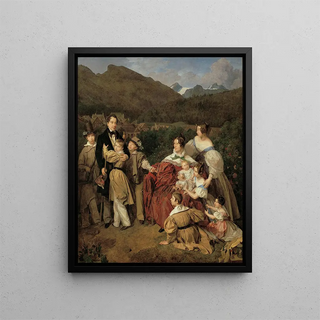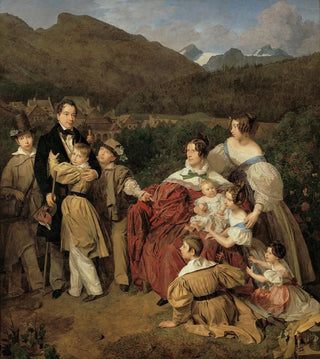Art print | The notary Dr. Josef August Eltz with his wife Caroline née Schaumburg and their eight children in Ischl - Ferdinand Georg Waldmüller


View from behind

Frame (optional)
In the panorama of 19th-century Austrian art, the work of Ferdinand Georg Waldmüller stands out for its ability to capture the very essence of everyday life. The art print Le notaire Dr. Josef August Eltz with his wife Caroline née Schaumburg and their eight children in Ischl asserts itself as a vibrant family scene, illustrating not only the dynamics of a bygone era but also the intimacy of a family unit. This piece, imbued with warmth and realism, invites the viewer on a journey through time, where each face, each gesture, tells a story. Through this painting, Waldmüller does not merely depict his subjects; he immortalizes them in a moment of shared happiness, offering a profound insight into human relationships.
Style and uniqueness of the work
Waldmüller’s style is characterized by meticulous realism, which transcends simple representation to delve into the psychology of the characters. In this art print, details are carefully orchestrated, from facial expressions to the postures of the children; every element contributes to creating an atmosphere of conviviality and harmony. The colors, chosen with care, evoke the softness of natural light, bringing an almost tangible dimension to the canvas. The artist excels in capturing the nuances of human emotion, and this family scene is no exception. The children, engaged in various activities, seem to come alive under the benevolent gaze of their parents, while Caroline and Josef Eltz, at the center of the composition, radiate an aura of serenity and pride. This painting is much more than a simple depiction; it is a tableau of life, where every detail matters and where family harmony is highlighted.
The artist and his influence
Ferdinand Georg Waldmüller, an emblematic figure of Biedermeier, knew how to mark his era with an innovative approach to genre painting. By focusing on everyday life and domestic scenes, he paved the way for a new way of approaching art, far from classical ideals and historical representations. His technique, combining precision and sensitivity

Matte finish

View from behind

Frame (optional)
In the panorama of 19th-century Austrian art, the work of Ferdinand Georg Waldmüller stands out for its ability to capture the very essence of everyday life. The art print Le notaire Dr. Josef August Eltz with his wife Caroline née Schaumburg and their eight children in Ischl asserts itself as a vibrant family scene, illustrating not only the dynamics of a bygone era but also the intimacy of a family unit. This piece, imbued with warmth and realism, invites the viewer on a journey through time, where each face, each gesture, tells a story. Through this painting, Waldmüller does not merely depict his subjects; he immortalizes them in a moment of shared happiness, offering a profound insight into human relationships.
Style and uniqueness of the work
Waldmüller’s style is characterized by meticulous realism, which transcends simple representation to delve into the psychology of the characters. In this art print, details are carefully orchestrated, from facial expressions to the postures of the children; every element contributes to creating an atmosphere of conviviality and harmony. The colors, chosen with care, evoke the softness of natural light, bringing an almost tangible dimension to the canvas. The artist excels in capturing the nuances of human emotion, and this family scene is no exception. The children, engaged in various activities, seem to come alive under the benevolent gaze of their parents, while Caroline and Josef Eltz, at the center of the composition, radiate an aura of serenity and pride. This painting is much more than a simple depiction; it is a tableau of life, where every detail matters and where family harmony is highlighted.
The artist and his influence
Ferdinand Georg Waldmüller, an emblematic figure of Biedermeier, knew how to mark his era with an innovative approach to genre painting. By focusing on everyday life and domestic scenes, he paved the way for a new way of approaching art, far from classical ideals and historical representations. His technique, combining precision and sensitivity






